Sunnyvale, CA Pollen and Allergy Report for Summer 2023
Pollen Allergy Trends in Sunnyvale, CA
When is pollen lowest in Sunnyvale, CA?

February
Lowest month total PPM
Avg. PPM
When is pollen highest in Sunnyvale, CA?

May
Highest month total PPM
Avg. PPM
How does pollen in Sunnyvale, CA compare to California?
Sunnyvale has a lower average PPM than the state of California.
Sunnyvale yearly avg PPM:
California yearly avg PPM:
How does pollen in Sunnyvale, CA compare to the USA?
Sunnyvale has a lower average PPM than the USA.
Sunnyvale yearly avg PPM:
USA yearly avg PPM:
Is pollen worse this year in Sunnyvale, CA?
Spring 2023 was about the same as 2022.
Spring 2023 PPM:
Spring 2022 PPM:
Average PPM in Sunnyvale, CA


Sunnyvale, CA Pollen and Allergy Breakdown by Month
Grass
When is grass pollen highest in Sunnyvale, CA?
May has the highest grass pollen in Sunnyvale, CA with an average PPM of
When is grass pollen lowest in Sunnyvale, CA?
December has the lowest grass pollen in Sunnyvale, CA with an average PPM of
Tree
When is tree pollen highest in Sunnyvale, CA?
April has the highest tree pollen in Sunnyvale, CA with an average PPM of
When is tree pollen lowest in Sunnyvale, CA?
August has the lowest tree pollen in Sunnyvale, CA with an average PPM of
Weed
When is weed pollen highest in Sunnyvale, CA?
November has the highest weed pollen in Sunnyvale, CA with an average PPM of
When is weed pollen lowest in Sunnyvale, CA?
February has the lowest weed pollen in Sunnyvale, CA with an average PPM of
Sunnyvale, CA Pollen Monthly Breakdown by Pollen Type


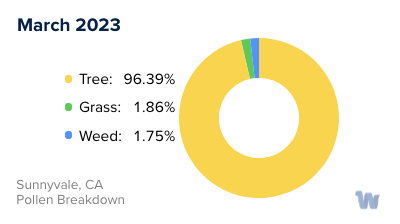
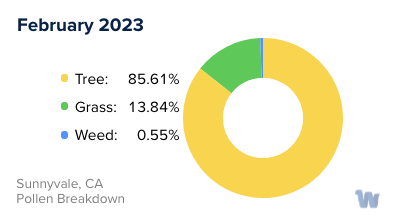
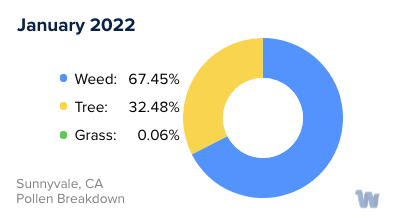

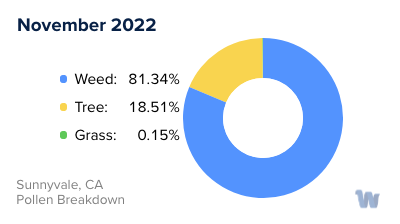
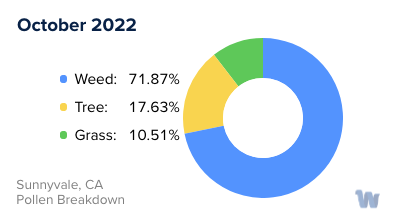

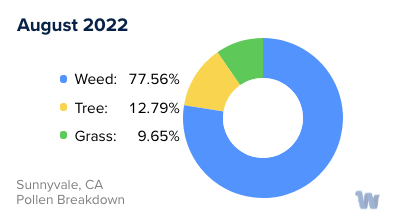


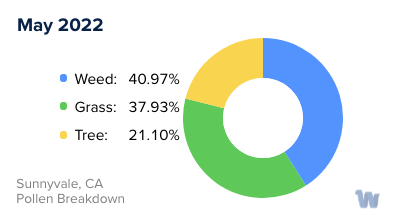
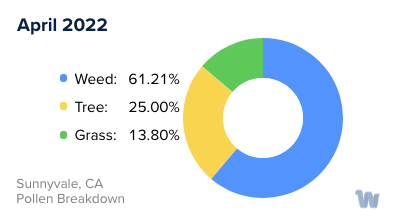


Pollen and Hay Fever in Sunnyvale, CA
In Sunnyvale, California, pollen allergies and hay fever are common health concerns that affect a significant proportion of the population. These conditions, also known as seasonal allergic rhinitis, are caused by an immune response to airborne pollen particles from a variety of local flora.
California's diverse vegetation means that Sunnyvale residents may experience pollen allergies from various sources throughout the year. The city's climate, coupled with its green spaces and its location within the larger Santa Clara Valley, contributes to an environment rich in plant life.
The primary pollen producers in Sunnyvale are trees, grasses, and weeds. In the early spring, typically from February to April, tree pollen becomes predominant. Oak, cedar, pine, and juniper trees are among the main culprits. These trees shed microscopic particles into the air, which can cause a host of symptoms in people who are allergic to them.
Following tree pollen season, grass pollen begins to circulate. From late spring to early summer, residents might find themselves sniffling and sneezing due to grasses such as ryegrass, Bermuda grass, and Timothy grass. Even well-maintained lawns and parks can unknowingly contribute to the pollen count during this time.
Lastly, weed pollen tends to become prevalent in late summer and fall. This includes plants like ragweed, sagebrush, and pigweed. Despite being less visible than trees or grasses, these weeds can generate substantial amounts of pollen, causing discomfort for many.
The severity and duration of pollen seasons in Sunnyvale can vary year by year, based on factors such as temperature, rainfall, and wind conditions. It's essential to remember that although these patterns generally hold, allergies can be highly individual. What triggers one person might not affect another. Understanding the local pollen seasons, and recognizing the specific types of pollen that affect you, can be a crucial step towards managing your pollen allergies in Sunnyvale.


